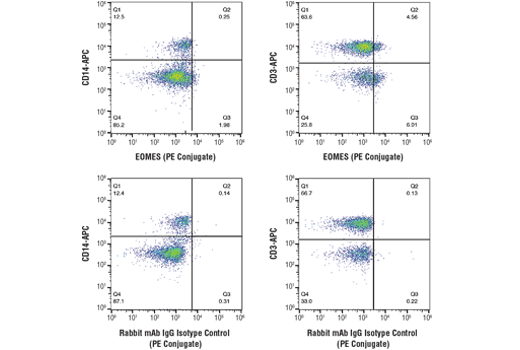FC-FP
H
Endogenous
Rabbit IgG
#O95936
8320
Product Information
Product Usage Information
| Application | Dilution |
|---|---|
| Flow Cytometry (Fixed/Permeabilized) | 1:50 |
Storage
Specificity / Sensitivity
Species Reactivity:
Human
Source / Purification
Monoclonal antibody is produced by immunizing animals with a synthetic peptide corresponding to residues surrounding Pro180 of human EOMES protein.
Product Description
Background
The T-box family of transcription factors is named for their shared homology with the DNA binding domain of the mouse brachyury (T) gene product. Members of this family bind DNA and are capable of transcriptional activation. They also have evolutionarily conserved expression patterns and roles in embryonic development, primarily mesoderm development (1). EOMES, or Tbr2 (T-box brain 2), is a master regulator of mesoderm formation that is also essential for trophoblast formation, gastrulation, neurogenesis, and the differentiation of certain T cell subsets. Embryos from EOMES knockout mice die soon after implantation due to their inability to develop a trophoblast (2,3). Conditional neural knockout mice show defects in development of a specific population of neural progenitors known as intermediate-stage progenitor cells (IPCs) that give rise only to neurons (4,5). These cells are formed from the radial glia in the ventricular and sub-ventricular zones of the cortex. Expression of EOMES increases as cells develop from radial glia to IPCs and then decreases as IPCs progress to neurons. Recent evidence suggests that EOMES and IPCs may also play a role in neurogenesis in the adult hippocampal SGZ (5). EOMES is also a key transcription factor for memory T cells and for full effector differentiation of CD8+ T cells (6). Expression of EOMES is induced in CD8+ T cells following viral infection and bacterial infection where sufficient IL-12 has been produced to elicit acute host cell response (7).
- Showell, C. et al. (2004) Dev Dyn 229, 201-18.
- Russ, A.P. et al. (2000) Nature 404, 95-9.
- Strumpf, D. et al. (2005) Development 132, 2093-102.
- Englund, C. et al. (2005) J Neurosci 25, 247-51.
- Hodge, R.D. et al. (2008) J Neurosci 28, 3707-17.
- Takayanagi, M. et al. (2003) Rheumatol Int 23, 315-8.
- Takemoto, N. et al. (2006) J Immunol 177, 7515-9.
Species Reactivity
Species reactivity is determined by testing in at least one approved application (e.g., western blot).
Applications Key
FC-FP: Flow Cytometry (Fixed/Permeabilized)
Cross-Reactivity Key
H: human M: mouse R: rat Hm: hamster Mk: monkey Vir: virus Mi: mink C: chicken Dm: D. melanogaster X: Xenopus Z: zebrafish B: bovine Dg: dog Pg: pig Sc: S. cerevisiae Ce: C. elegans Hr: horse GP: Guinea Pig Rab: rabbit All: all species expected
Trademarks and Patents
Limited Uses
Except as otherwise expressly agreed in a writing signed by a legally authorized representative of CST, the following terms apply to Products provided by CST, its affiliates or its distributors. Any Customer's terms and conditions that are in addition to, or different from, those contained herein, unless separately accepted in writing by a legally authorized representative of CST, are rejected and are of no force or effect.
Products are labeled with For Research Use Only or a similar labeling statement and have not been approved, cleared, or licensed by the FDA or other regulatory foreign or domestic entity, for any purpose. Customer shall not use any Product for any diagnostic or therapeutic purpose, or otherwise in any manner that conflicts with its labeling statement. Products sold or licensed by CST are provided for Customer as the end-user and solely for research and development uses. Any use of Product for diagnostic, prophylactic or therapeutic purposes, or any purchase of Product for resale (alone or as a component) or other commercial purpose, requires a separate license from CST. Customer shall (a) not sell, license, loan, donate or otherwise transfer or make available any Product to any third party, whether alone or in combination with other materials, or use the Products to manufacture any commercial products, (b) not copy, modify, reverse engineer, decompile, disassemble or otherwise attempt to discover the underlying structure or technology of the Products, or use the Products for the purpose of developing any products or services that would compete with CST products or services, (c) not alter or remove from the Products any trademarks, trade names, logos, patent or copyright notices or markings, (d) use the Products solely in accordance with CST Product Terms of Sale and any applicable documentation, and (e) comply with any license, terms of service or similar agreement with respect to any third party products or services used by Customer in connection with the Products.
